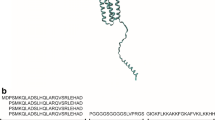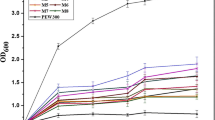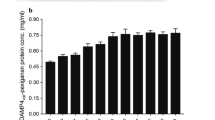Abstract
Antimicrobial peptides (AMPs) have been paid considerable attention owing to their broad-spectrum antimicrobial activity and have great potential as novel antimicrobials. In this study, a novel hybrid peptide LF15-CA8 was designed on the basis of bovine lactoferricin (LfcinB) and cecropin A. The gene segment encoding LF15-CA8 was synthesized and cloned into pGEX-4T-BH to form pGEX-4T-LC1 containing one copy of the LF15-CA8 coding region. A series of recombinant vectors containing up to six multiple-copy LF15-CA8 coding regions, i.e., pGEX-4T-LCn (n = 1–6), were subsequently constructed, and used for transformation in Escherichia coli BL21(DE3). After induction with IPTG, pGEX-4T-LC1 and pGEX-4T-LC2 transformants successfully expressed fusion proteins GST-LF15-CA8 and GST-(LF15-CA8)2 in the form of inclusion bodies, respectively. The inclusion bodies were dissolved and the peptide was successfully released in 70 % formic acid in a single step. After purification, about 10.0 mg of the recombinant peptide LF15-CA8 with purity more than 97 % was obtained from 1 l of bacteria culture of pGEX-4T-LC2 transformants. LF15-CA8 caused an increase in antibacterial activity against Gram-positive bacterium (Staphylococcus aureus ATCC 25923) compared with the parent peptides and did not show obvious hemolytic activity against human erythrocytes in the range of effective antibacterial concentration. These results suggest that the peptide LF15-CA8 could be a promising candidate for therapeutic applications, and may lead to a cost-effective solution for the large-scale production of AMPs.





Similar content being viewed by others
References
Andreu D, Ubach J, Boman A, Wåhlin B, Wade D, Merrifield RB, Boman HG (1992) Shortened cecropin A-melittin hybrids. Significant size reduction retains potent antibiotic activity. FEBS Lett 296(2):190–194
Bang SK, Kang CS, Han MD, Bang IS (2010) Expression of recombinant hybrid peptide Hinnavin II/aIpha-melanocyte-stimulating hormone in Escherichia coli: purification and characterization. J Microbiol 48(1):24–29
Bellamy W, Takase M, Wakabayashi H, Kawase K, Tomita M (1992) Antibacterial spectrum of lactoferricin B, a potent bactericidal peptide derived from the N-terminal region of bovine lactoferrin. J Appl Bacteriol 73(6):472–479
Bradford MM (1976) A rapid and sensitive method for the quantization of microgram quantities of protein utilizing the principle of protein-dye binding. Anal Biochem 72:248–254
Brogden KA (2005) Antimicrobial peptides: pore formers or metabolic inhibitors in bacteria? Nat Rev Microbiol 3(3):238–250
Cao Y, Yu RQ, Liu Y, Zhou HX, Song LL, Cao Y, Qiao DR (2010) Design, recombinant expression, and antibacterial activity of the cecropins-melittin hybrid antimicrobial peptides. Curr Microbiol 61(3):169–175
Chen ZJ, Wang DM, Cong YG, Wang J, Zhu JM, Yang J, Hu Z, Hu XM, Tan YL, Hu FQ, Rao XC (2011) Recombinant antimicrobial peptide hPAB-β expressed in Pichia pastoris, a potential agent active against methicillin-resistant Staphylococcus aureus. Appl Microbiol Biotechnol 89(2):281–291
Ferre R, Melo MN, Correia AD, Feliu L, Bardají E, Planas M, Castanho M (2009) Synergistic effects of the membrane actions of cecropin-melittin antimicrobial hybrid peptide BP100. Biophys J 96(5):1815–1827
Gifford JL, Hunter HN, Vogel HJ (2005) Lactoferricin: a lactoferrin-derived peptide with antimicrobial, antiviral, antitumor and immunological properties. Cell Mol Life Sci 62(22):2588–2598
Guani-Guerra E, Santos-Mendoza T, Lugo-Reyes SO, Teran LM (2010) Antimicrobial peptides: general overview and clinical implications in human health and disease. Clin Immunol 135(1):1–11
Hultmark D, Steiner H, Rasmuson T, Boman HG (1980) Insect immunity, purification and properties of three inducible bactericidal proteins from emolymph of immunized pupae of Hyalophora cecropia. Eur J Biochem 106(1):7–16
Iost I, Dreyfus M (1995) The stability of Escherichia coli lacZ mRNA depends upon the simultaneity of its synthesis and translation. EMBO J 14(13):3252–3261
Jang SA, Kim H, Lee JY, Shin JR, da Kim J, Cho JH, Kim SC (2012) Mechanism of action and specificity of antimicrobial peptides designed based on buforin IIb. Peptides 34(2):283–289
Jonasson P, Nygren PA, Jornvall H, Johansson BL, Wahren J, Uhlen M, Stahl S (2000) Integrated bioprocess for production of human proinsulin C-peptide via heat release of an intracellular heptameric fusion protein. J Biotechnol 76(2–3):215–226
Khan J, Gupta S, Chattopadhyay K, Mukhopadhaya A (2012) Refolding and functional assembly of the Vibrio cholerae porin OmpU recombinantly expressed in the cytoplasm of Escherichia coli. Protein Expr Purif 85(2):204–210
Kim JM, Jang SA, Yu BJ, Sung BH, Cho JH, Kim SC (2008) High-level expression of an antimicrobial peptide histonin as a natural form by multimerization and furin-mediated cleavage. Appl Microbiol Biotechnol 78(1):123–130
Kovaleva V, Krynytskyy H, Gout I, Gout R (2011) Recombinant expression, affinity purification and functional characterization of Scots pine defensin 1. Appl Microbiol Biotechnol 89(4):1093–1101
Lee DG, Park Y, Jin I, Hahm KS, Lee HH, Moon YH, Woo ER (2004) Structure-antiviral activity relationships of cecropin A-magainin 2 hybrid peptide and its analogues. J Pept Sci 10(5):298–303
Lee JH, Kim MS, Cho JH, Kim SC (2002) Enhanced expression of tandem multimers of the antimicrobial peptide buforin II in Escherichia coli by the DEAD-box protein and trxB mutant. Appl Microbiol Biotechnol 58(6):790–796
Lee M, Bang K, Kwon H, Cho S (2013) Enhanced antibacterial activity of an attacin-coleoptericin hybrid protein fused with a helical linker. Mol Biol Rep 40(6):3953–3960
Mader JS, Salsman J, Conrad DM, Hoskin DW (2005) Bovine lactoferricin selectively induces apoptosis in human leukemia and carcinoma cell lines. Mol Cancer Ther 4(4):612–624
Maher S, McClean S (2006) Investigation of the cytotoxicity of eukaryotic and prokaryotic antimicrobial peptides in intestinal epithelial cells in vitro. Biochem Pharmacol 71(9):1289–1298
Miller KW, Evans RJ, Eisenberg SP, Thompson RC (1989) Secretory leukocyte protease inhibitor binding to mRNA and DNA as a possible cause of toxicity to Escherichia coli. J Bacteriol 171(4):2166–2172
Moore AJ, Beazley WD, Bibby MC, Devine DA (1996) Antimicrobial activity of cecropins. J Antimicrob Chemother 37(6):1077–1089
Park TJ, Kim JS, Choi SS, Kim Y (2009) Cloning, expression, isotope labeling, purification, and characterization of bovine antimicrobial peptide, lactophoricin in Escherichia coli. Protein Expr Purif 65(1):23–29
Paulsen VS, Blencke HM, Benincasa M, Haug T, Eksteen JJ, Styrvold OB, Scocchi M, Stensvåg K (2013) Structure-activity relationships of the antimicrobial peptide arasin 1 and mode of action studies of the N-terminal, proline-rich region. PLoS ONE 8(1):e53326
Sambrook J, Fristsch EF, Maniatis T (1989) In: Sambrook J (ed) Molecular cloning: a laboratory manual, 3rd edn. Cold Spring Harbor Laboratory Press, New York, pp 96–99
Schagger H, von Jagow G (1987) Tricine–sodium dodecyl sulfate–polyacrylamide gel electroporesis for the separation of proteins in the range from 1 to 100 kDa. Anal Biochem 166(2):368–379
Shen Y, Ai HX, Song R, Liang ZN, Li JF, Zhang SQ (2010) Expression and purification of moricin CM4 and human β-defensins 4 in Escherichia coli using a new technology. Microbiol Res 165(8):713–718
Spížek J, Novotná J, Rezanka T, Demain AL (2010) Do we need new antibiotics? The search for new targets and new compounds. J Ind Microbiol Biotechnol 37(12):1241–1248
Tian ZG, Dong TT, Yang YL, Teng D, Wang JH (2009) Expression of antimicrobial peptide LH multimers in Escherichia coli C43(DE3). Appl Microbiol Biotechnol 83(1):143–149
Wang LN, Yu B, Han GQ, He J, Chen DW (2010) Design, expression and characterization of recombinant hybrid peptide Attacin–Thanatin in Escherichia coli. Mol Biol Rep 37(7):3495–3501
Wiesner J, Vilcinskas A (2010) Antimicrobial peptides: the ancient arm of the human immune system. Virulence 1(5):440–464
Wu GQ, Deng XP, Li XF, Wang XY, Wang SL, Xu HM (2011) Application of immobilized thrombin for production of S-thanatin expressed in Escherichia coli. Appl Microbiol Biotechnol 92(1):85–93
Zasloff M (2002) Antimicrobial peptides of multicellular organisms. Nature 414(6870):389–395
Zhang JL, Peng S, Cheng X, Wang HY (2012) Functional analysis of hybrid peptide CAMA-Syn: expression in mammalian cells and antimicrobial potential. Protein Pept Lett 19(10):1076–1081
Zhao PW, Cao GF (2012) Production of bioactive sheep β-defensin-1 in Pichia pastoris. J Ind Microbiol Biotechnol 39(12):11–17
Acknowledgments
This work was supported by the National Natural Science Foundation of China (30800794), Program for Young Aged Academic Staff in the Heilongjiang Province Ordinary College (1252G010), and Research Fund for Innovation Talents of Science and Technology in Harbin City (2012RFQXN022).
Author information
Authors and Affiliations
Corresponding authors
Rights and permissions
About this article
Cite this article
Feng, XJ., Xing, LW., Liu, D. et al. Design and high-level expression of a hybrid antimicrobial peptide LF15-CA8 in Escherichia coli . J Ind Microbiol Biotechnol 41, 527–534 (2014). https://doi.org/10.1007/s10295-013-1382-3
Received:
Accepted:
Published:
Issue Date:
DOI: https://doi.org/10.1007/s10295-013-1382-3




